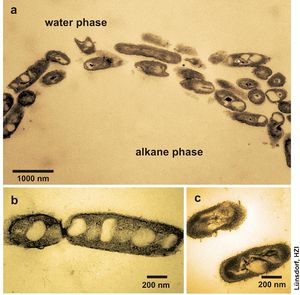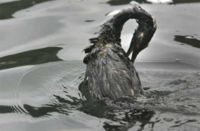Microvirgula aerodenitrificans: Difference between revisions
| Line 26: | Line 26: | ||
Until 2012, Microvirgula aerodenitrificans has not been described as a causative organism of clinical infection. However, the first human case has been recently reported in where M. aerodenitrificans was linked to bacteremia in a 15-month-old infant boy with Pompe’s disease. The disease causality of the organism itself is not yet proven but it is shown that such organism can influence vascular access mechanism and may lead to a clinical disease especially for a person with an immunodeficiency [2]. | Until 2012, Microvirgula aerodenitrificans has not been described as a causative organism of clinical infection. However, the first human case has been recently reported in where M. aerodenitrificans was linked to bacteremia in a 15-month-old infant boy with Pompe’s disease. The disease causality of the organism itself is not yet proven but it is shown that such organism can influence vascular access mechanism and may lead to a clinical disease especially for a person with an immunodeficiency [2]. | ||
== | ==Morphology and Classification== | ||
Microvirgula aerodenitrificans was first isolated from an activated sludge in 1998 by Patureau et al. This microorganism is a curved, rod shaped (vibrio), motile, gram negative, catalase- and oxidase- positive, and aerobically denitrifying bacteria [5]. It is also a mesophile and neutrophilic organism, where the maximal growth occurs at 35oC and pH 7 [5]. The organism still shows growth at temperature range between 15oC to 45oC and under pH 6 [5]. The size of the cell varies within a growth stage [5]. At the beginning of the growth stage, it has a thin shape but becomes larger and associate with 4-5 cells by the late stationary phase [5]. Based on these phenotypic characteristics, M. aerodenitrificans is the most close to Cornarnonas testosteroni and Pseudomonas alcaligenes [1, 5] | |||
M. aerodenitrificans is a typical Gram negative cell wall structure, which includes two layers of membranes, outer and inner, revealed with an undulating outer membrane [5]. The isolated colonies after a 24 h incubation period were shown to be circular with 1±2 mm diameter and cream-coloured [5] In young cultures, cells occurred as singly or in pairs. Under a negative staining electron microscopy, a thin section of M. aerodenitrificans possesses bipolar tufts of flagella [5]. | |||
It | |||
==Cell Structure, Metabolism and Life Cycle== | ==Cell Structure, Metabolism and Life Cycle== | ||
Revision as of 02:10, 14 December 2012

Classification
Domain: Bacteria
Phylum: Proteobacteria
Class: Betaproteobacteria
Order: Neisseriales
Family: Neisseriaceae
Genus: Microvirgula
Species: aerodenitrificans
Species
Microvirgula aerodenitrificans
Introduction
M. aerodenitrificans are abile to performs denitrification under aerobic condition [1,3,5]. While most denitrifiers utilize nitrate and nitrite as terminal electron acceptors under anaerobic conditions, , M. aerodenitrificans reduces both oxygen and nitrogen simultaneously when oxygen is present [5]. However, the biological significance is not defined yet for aerobic denitrification. The habitat for this organism is not specified and found in a various places globally where selective pressure such as fluctuating oxygen concentration occurs[7,8]. These places are mostly sludge, mixture of wastewater treatment and also found in canal and a pond [8]. Until 2012, Microvirgula aerodenitrificans has not been described as a causative organism of clinical infection. However, the first human case has been recently reported in where M. aerodenitrificans was linked to bacteremia in a 15-month-old infant boy with Pompe’s disease. The disease causality of the organism itself is not yet proven but it is shown that such organism can influence vascular access mechanism and may lead to a clinical disease especially for a person with an immunodeficiency [2].
Morphology and Classification
Microvirgula aerodenitrificans was first isolated from an activated sludge in 1998 by Patureau et al. This microorganism is a curved, rod shaped (vibrio), motile, gram negative, catalase- and oxidase- positive, and aerobically denitrifying bacteria [5]. It is also a mesophile and neutrophilic organism, where the maximal growth occurs at 35oC and pH 7 [5]. The organism still shows growth at temperature range between 15oC to 45oC and under pH 6 [5]. The size of the cell varies within a growth stage [5]. At the beginning of the growth stage, it has a thin shape but becomes larger and associate with 4-5 cells by the late stationary phase [5]. Based on these phenotypic characteristics, M. aerodenitrificans is the most close to Cornarnonas testosteroni and Pseudomonas alcaligenes [1, 5] M. aerodenitrificans is a typical Gram negative cell wall structure, which includes two layers of membranes, outer and inner, revealed with an undulating outer membrane [5]. The isolated colonies after a 24 h incubation period were shown to be circular with 1±2 mm diameter and cream-coloured [5] In young cultures, cells occurred as singly or in pairs. Under a negative staining electron microscopy, a thin section of M. aerodenitrificans possesses bipolar tufts of flagella [5].
Cell Structure, Metabolism and Life Cycle
Alcanivorax borkumensis, a Gram-negative, rod-shaped chemoorganotroph, is able to use n-alkanes as its principle carbon and energy source by use of the broad spectrum of oil-degrading enzymes it possesses, but they can also use a limited number of organic compounds such as aliphatic hydrocarbons, volatile fatty acids, and pyruvate. However, it cannot utilize carbon sources such as sugars or amino acids. Cells grown with pyruvate were observed to be 2.0-3.0 micrometers in length and 0.4-07 micrometers in diameter, however, cells were shorter (1.0-1.5 micrometers in length) when cells were grown with n-alkanes as the carbon source (see Figure 1) [5]. When the slow growing A. borkumensis uses n-alkanes exclusively, the microbes produce extracellular and membrane-bound surface-active glucose lipids called biosurfactants. These biosurfactants reduce the surface tension of water from 72 to 29 mN m-1 and act as natural emulsifiers which enhances the break up of oil-in-water emulsions [4,5]. Due to the low solubility of oil in water, most oil degradation takes place at the oil-water interface where A. borkumensis attaches and forms a biofilm around the oil droplets as depicted in Figure 3.
Ecology
Alcanivorix is a novel species living in the oceans that plays a major role in keeping our pristine oceans as well as the inhabitants of the ocean and the inhabitants of the coastal regions in good health. It has been detected worldwide in places such as the Mediterranean Sea, Pacific Ocean, and the Arctic Sea [4]. In seawater with high concentrations of n-alkanes (as a result of oil spills, natural oil fields, and/or processing plants), Alcanivorax quickly becomes the predominant microbial community and is found in higher populations when compared to Alcanivorax in unpolluted seawater. There have been several recent fields studies on bacterial community dynamics and hydrocarbon degradation in coastal areas contaminated with oil. These field studies have demonstrated the immense importance of Alcanivorax (particularly A. Borkumensis) in oil-spill bioremediation [2].
References
[3] Lorenzo, Víctor De. "Blueprint of an Oil-eating Bacterium." Nature Biotechnology 24 (2006): 952-953.
Author
Page authored by Andrew Buss, student of Prof. Jay Lennon at Michigan State University.

